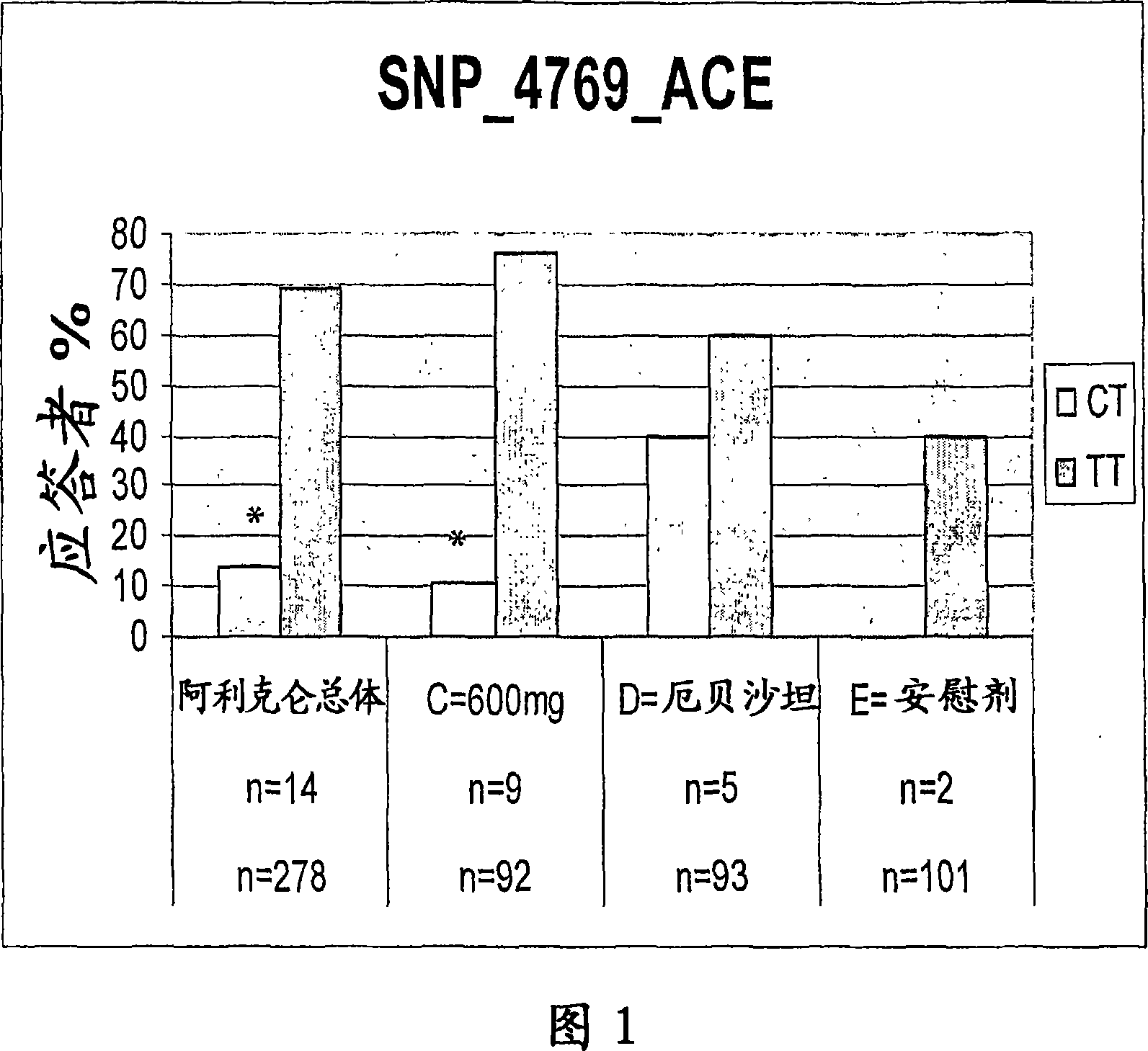Biomarkers for efficacy of aliskiren as a hypertensive agent
An antihypertensive drug, a technique for high blood pressure, applied in the field of genetic polymorphism
- Summary
- Abstract
- Description
- Claims
- Application Information
AI Technical Summary
Problems solved by technology
Method used
Image
Examples
Embodiment I
[0018] All doses of active treatment were statistically superior to placebo at clinical trial endpoints for mean sitting systolic blood pressure (MSSBP). Both 300 and 600 mg aliskiren were statistically stronger than placebo and irbesartan at clinical trial endpoints. Similar reductions in MSSBP were obtained with 150 mg Aliskiren and 150 mg Irbesartan. Aliskiren 300 mg and 600 mg produced the greatest reduction, see Example I below.
[0019] In the pharmacogenetic analysis, 48 polymorphisms from the renin-angiotensin-aldosterone system (RAS) or 12 genes previously implicated in blood pressure regulation were examined. One polymorphism in the angiotensin converting enzyme (ACE) gene (SNP_4769, SEQ ID NO: 1), two polymorphisms in the angiotensin II receptor type 2 (AGTR2) gene (SNP_1445, SEQ ID NO: 2 and SNP_4795, SEQ ID NO: 3) and the clinical parameters of mean sitting diastolic and systolic blood pressure drop. No such effect was found for irbesartan and placebo treatme...
Embodiment
[0181] Aliskiren versus placebo and irbesartan in patients with mild to moderate essential hypertension Introduction and Overview
[0182] A retrospective pharmacogenetic analysis was performed in an attempt to evaluate the potential association between genetic variants and clinical outcomes in clinical trials. Specifically, 48 polymorphisms were detected in 12 genes from the renin-angiotensin-aldosterone system (RAS) or previously shown to be involved in blood pressure regulation. Between one polymorphism in the angiotensin-converting enzyme (ACE) gene, two polymorphisms in the angiotensin II receptor type II (AGTR2) gene, and clinical parameters of mean sitting diastolic and systolic blood pressure drop A significant correlation can be seen. These effects were not seen with irbesartan and placebo treatment, instead the effect was specific to aliskiren treatment in this analysis.
[0183] Clinical Trials
[0184] A multi-channel randomized double-blind parallel group clini...
Embodiment II
[0241] Clinical Pharmacogenetic Analysis of Clinical Trial A2203
[0242] Introduction and Overview
[0243] A retrospective pharmacogenetic analysis was performed in an attempt to assess the potential correlation between genetic variation and clinical outcomes in clinical trials, see Example I. Subsequently, for repeat analysis, the results of another clinical trial (A2203) were considered. Specifically, we examined 48 polymorphisms in 12 genes from the renin-angiotensin-aldosterone system (RAS) and previously implicated in blood pressure regulation.
[0244] In Example 1, one polymorphism in the angiotensin-converting enzyme (ACE) gene, two polymorphisms in the angiotensin II receptor type 2 (AGTR2) gene were associated with the clinical parameters mean sitting diastolic blood pressure and systolic A significant correlation was seen between the pressure drop. These effects were not seen with irbesartan and placebo treatment. Furthermore, for the ACE missense variant (Pro...
PUM
 Login to View More
Login to View More Abstract
Description
Claims
Application Information
 Login to View More
Login to View More - R&D
- Intellectual Property
- Life Sciences
- Materials
- Tech Scout
- Unparalleled Data Quality
- Higher Quality Content
- 60% Fewer Hallucinations
Browse by: Latest US Patents, China's latest patents, Technical Efficacy Thesaurus, Application Domain, Technology Topic, Popular Technical Reports.
© 2025 PatSnap. All rights reserved.Legal|Privacy policy|Modern Slavery Act Transparency Statement|Sitemap|About US| Contact US: help@patsnap.com

